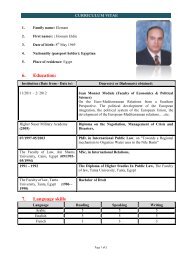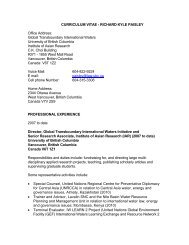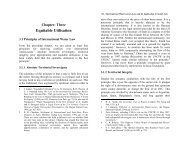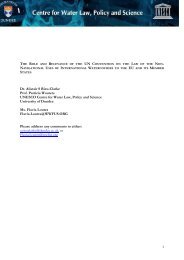Upreti, Trilochan, International Watercourses Law and Its Application ...
Upreti, Trilochan, International Watercourses Law and Its Application ...
Upreti, Trilochan, International Watercourses Law and Its Application ...
Create successful ePaper yourself
Turn your PDF publications into a flip-book with our unique Google optimized e-Paper software.
222 / <strong>International</strong> <strong>Watercourses</strong> <strong>Law</strong> <strong>and</strong> <strong>Its</strong> <strong>Application</strong> in South Asia Prospects <strong>and</strong> Problems of Nepalese Water Resources / 223cumecs capacity only), bypassing the old Sarada barrage. In thedownstream area of the project, the Mahakali Irrigation Projectin Nepalese territory was already in operation, which couldhave suffered adverse effects from such an upstream diversion.Without giving either due notice or any technical information toNepal, India carried out this project almost as if on a warfooting, irrespective of such obvious adverse effects. Nepalvoiced her concerns about the proposed project, but they werenot heard or the corrections implemented until the 1992 JointCommuniqué between the Prime Ministers of both countries,contrary to the rules of ‘equitable utilisation’ <strong>and</strong> ‘no harm’.Only in the Joint Communiqué was it agreed that the Tanakpurtailrace waters should be discharged upstream of the Mahakalibarrage so as not to affect existing consumptive use in Nepal. 131The Tanakpur barrage, a fait accompli once constructed,aggravated situations already controversial in Nepalese politicalcircles <strong>and</strong> serious questions were asked about the future ofIndo-Nepal relations. This was only settled after the conclusion<strong>and</strong> ratification of the Integrated Mahakali Treaty in 1996. The120 MW hydroelectric project lies below the proposedPancheshwar dam site <strong>and</strong> a little above the old Sarada barrageat Banbasa. A short 577 M long afflux bund (embankment orcauseway in India <strong>and</strong> Pakistan) (occupying some 2.9 ha ofl<strong>and</strong>) has been constructed, with the consent of the Nepalesegovernment (consent which was only sought retrospectively),tying the barrage to high ground in Nepal as a flood protectionmeasure. The afflux bund is in Nepal <strong>and</strong> remains underNepalese sovereignty. 132 However, as no amendments orcorrections were made to address Nepalese concerns <strong>and</strong>interests, no further co-operation was possible; this was a caseof a dichotomy of perceptions between two states. After a longdispute <strong>and</strong> general outcry in Nepal, several negotiations were131 S. C. McCaffrey, The <strong>Law</strong> of <strong>International</strong> <strong>Watercourses</strong>, Oxford:Oxford University, 2001, p. 348; also see D. Gyawali <strong>and</strong> O. Schwank,"Interstate Sharing of Waters Rights: An Alps-HimalayanComparison" (1994) in 4 Water Nepal, p. 234.132 Supra note 44.held <strong>and</strong> finally an agreement was concluded, with theMakhakali treaty of 1996.As a result of the conclusion of a new treaty <strong>and</strong> the inclusionof Tanakpur in it, Nepal has benefited from the project inseveral ways. She is being provided with 150 cusecs of water(from a 1000 cusec capacity). Additionally, Tanakpur had aregulator constructed in order to irrigate some 4,000 to 5,000hectares of l<strong>and</strong> in Nepal; an annual supply of 70 million KWhoursunits of energy ‘free of charge’ 133 was provided <strong>and</strong> aroad link was built from the barrage to connect with Nepal'seast-west highway at Mahendranagar. It should be possible forIndia to divert a full 1000 cusecs supply to satisfy Nepal’sdesire for water from this project (in contrast to the initialdiversion of 150 cusecs), once the Pancheshwar storage dam iscompleted.4.11 Issues of Downstream BenefitsWater diplomacy is indeed a very sensitive issue in the entireregion of south Asia; Nepal has come to underst<strong>and</strong> that waterresources are both a symbol of national identity <strong>and</strong> pride, <strong>and</strong>a source of economic potential. Thus, its utilisation has becomethe key strategy for the development of the nation. A precisedefinition of downstream benefits upon which all are agreedcannot be found; however, if any water resources projectactivities in the upper reach of an IWC yield any type of benefitto the lower reach of a catchment area or downstream country,these are called 'downstream benefits'. 134 In principle <strong>and</strong> inpractice, such benefits must be shared equally <strong>and</strong> equitably.Professors Bourne, McCaffrey <strong>and</strong> Utton hold the view that:“There is support for the existence of a principle ofdownstream benefits in customary international133 Ibid. The term ‘free of charge’ does not seem appropriate for Nepal’sentitlement.134 T. <strong>Upreti</strong>, "A Perspective on Downstream Benefits" in the Kathm<strong>and</strong>uPost, June 24, (2000), p. 10.












